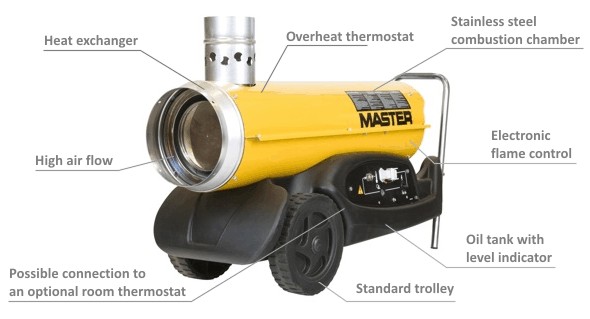
Heating A Warehouse - Different ways to heat your workplace
Heating a warehouse can end up being costly because of the large, often cold areas. Warehouses will have large loading bays with their doors opening and closing all day meaning cold air is constantly coming into the building. On cold winter days, it can be difficult to ensure all of your staff are warm and comfortable which led to the advent of a range of heaters - gas heaters, electric heaters, radiant heaters etc. We will be looking at the different types of heaters available and where to use them.
Heating machinery - Factory & Warehouse Industrial Heaters
In addition to all services and installations for warm air heating systems, Abercorn Heating specialises in factory and warehouse heating. Our customers know where to go for skilled professional servicing, given by knowledgeable industrial heating professionals, and backed by a great guarantee when it comes to factory heating installation.
Thermostat
A thermostat is a temperature-regulating mechanism that detects the temperature of a specific place and takes action to keep the temperature close to a specific setting. Any system or gadget that heats or cools to a setpoint temperature uses a thermostat.
Electric Heater
Electric heaters use relatively inexpensive tools to directly convert electrical energy into heat energy with a conversion efficiency of roughly 100%. Some of these heaters come with a thermostat to control the amount of energy being used. Applications that are frequently used include industrial processes, cooking, water heating, and space heating.
Electric space heater
A heating appliance that concentrates heat in a single room or small zone is an electric space heater. Through the use of a fan, they evacuate hot air, which rises naturally and drives colder air to the floor. This procedure aids in efficient heat distribution throughout the room.
Industrial electric fan heater
An Industrial electric fan heater is a warm air electric heater with axial fans, a metal body, and electric heating elements that are used to heat industrial applications or spaces like industrial halls, workshops, warehouses, stores, commercial pavilions, sports and entertainment venues, etc. Industrial electric heaters come in many different sizes.
Infrared radiant heaters - How do they differ from a radiant heater?
A radiant heater and an infrared radiant heater are the same thing - An infrared radiant heater generates infrared radiation, which travels through the air and is absorbed by items it comes into contact with, causing their molecules to vibrate and directly raising the temperature of the object. If you compare a radiant heater to convective heaters which warm the air in an area before heating individuals there. Convection heaters can be efficient in a contained place (inside), it usually escapes into the environment before having a significant impact on people in outdoor spaces, leading to inefficient heating at a high cost. Having a radiant heater will heat the people and things around it, not the air. A radiant heater is perfect for small work areas of a warehouse or factory.
Gas heaters
A gas heater is a space heater that uses propane, butane, liquefied petroleum gas, or natural gas to heat a space or an outdoor area. Fluid or non-fluid, or vented and unvented, are the two basic categories into which indoor residential gas heaters can be divided. Some of these heaters come with a thermostat to allow you to control the heat output.
Gas space heater
When maintained correctly and operated according to instructions, indoor gas heaters are quite safe. Gas heating will quickly heat your home and consume a lot less energy than an electric heater because it produces more heat output. The operating costs of a gas heater are typically lower and more economical than using electricity from the grid because gas is also an inexpensive, easy fuel.
Portable gas heaters
Portable gas heaters are as the name suggests - gas heaters that are portable. This means that these heaters are small enough to move to other areas and rooms so you can get the heating benefit in different places with just one heater.
Applications for industrial electric heaters
Industrial heaters have a plethora of uses. The following are some of the main industries that use them in one way or another:
- Industrial Chemicals
- Treatment of Water
- Oil & Gas Sector
- Atomic Power Facilities
- Systematic HVAC
- Biomass dryers
- Food and drink industry
- Steam generation
How do industrial electric fan heaters work?
Through the use of a resistive heating coil, an industrial electric fan heater turns electrical energy into heat energy. A fan is then used to circulate the air over the heating coil, where it is warmed before being forced into the space that needs to be heated.
Industrial electric space heaters - How to work out how much heat is needed for an area
This can be difficult to work out so I have included an example to illustrate how much heat should be required:
If a structure has all doors, windows, and a roof but no insulation and is 3,500 square feet with 10-foot ceilings (35,000 cubic feet), and you want the temperature to rise by 30 degrees, then you will require 84,000 BTU/hour to heat that area to the desired temperature.
BTU = British Thermal Unit
